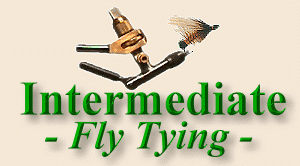One of my goals when I started this series was to keep the costs of the
patterns I show you to a minimum. In some cases, the costs can't be kept
too low because the materials needed for the flies just cost a lot. For
instance, dry fly hackle costs a lot no matter how you look at it, and I
can't prevent that. However, you haven't seen me lock you into a
situation where you must buy a specific type of foam or unusual feather
that costs a bundle.
I haven't tried to keep the costs down to benefit me. I have some
fairly expensive materials that you won't buy easily, but what good would
that do you? As we venture into the world of salmon flies, it would be
easy to show patterns that use blue heron feathers or authentic jungle
cock cheeks. I won't do that to you; it wouldn't promote your interest
in the flies.
This pattern is called a poor man's spey because it only uses common
materials you can find easily at a low price. Some of the classic salmon
fly folks will probably cringe at the thought of using something other
than authentic materials for something as sacred as a salmon fly, but the
idea here is to learn how to do it, not how expensive it can be. You can
learn how to perform the techniques with less expensive or less exotic
materials; then if you wish, you can bust the bank for the traditional
stuff. It's your choice.
Spey flies have a living, breathing motion in the water that's unmatched
by any other type of fly. Traditional spey hackle is fairly difficult to
find and usually costs quite a bit compared to other tying materials.
Some of the substitute materials (schlappen for example) are just about
as expensive as the originals, but they are easier to find.
If you're fairly handy with bleach and dyes, you can create some pretty
good substitutions yourself. Upland game birds like pheasants and grouse
have some great feathers that can be bleached or dyed and used in
substitution for the rare feathers called for in some patterns. Common
feathers like mallard flank and guinea can be dyed to do a terrific job
of replacing a rare feather. All you need is some dye, some bleach and
something like vinegar or boric acid to help the colors set properly. I
didn't even bother dying the feathers I'll be using today. You can see
the techniques without the dye, and this color works well on the local
fish.
If you spend some time in craft stores and visiting with your friends
who do a lot of bird hunting, you'll probably wind up with a lot of
suitable materials to create as many spey type flies as you want. What
you need to look for is long, fibrous feathers that will breathe and sway
in the water with the slightest twitch of the rod tip or the tiniest pull
of the current.
Landlocked folks like me might be tempted to pass up spey flies. After
all, they are for salmon, right? Right, but they catch bass, large
trout, pike and an occasional carp. One of my favorite springtime
walleye flies is a purple colored spey fly tied exactly like the fly I'll
show you today. The only difference between that fly and the one you are
about to tie is the fact that I dye all of the hackles purple before I
tie with them. I also use the brown version a lot, and the fish seem to
like it, so I won't quit.
OK, I know there's bound to be a few out there yelling "heresy" by now.
If I go on much longer, I'm bound to be excommunicated from the holy
church of the salmon fly, so let's just tie the fly and learn a technique
or two.
|
















